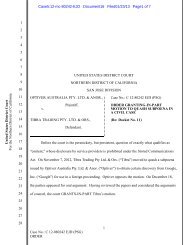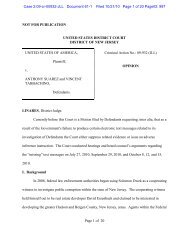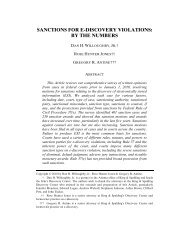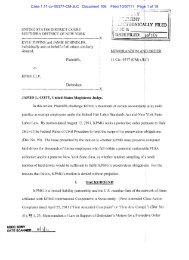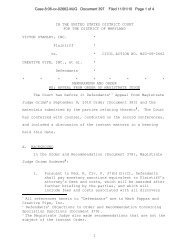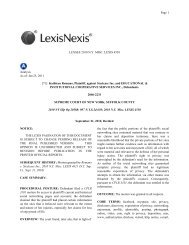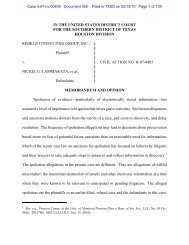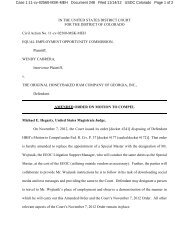Katiroll Company, Inc. v. Kati Roll and Platters - E-Discovery Law Alert
Katiroll Company, Inc. v. Kati Roll and Platters - E-Discovery Law Alert
Katiroll Company, Inc. v. Kati Roll and Platters - E-Discovery Law Alert
Create successful ePaper yourself
Turn your PDF publications into a flip-book with our unique Google optimized e-Paper software.
2011 U.S. Dist. LEXIS 85212, *<br />
Page 2<br />
This motion focuses on the discovery positions of the<br />
parties. Particularly, this motion focuses on whether Defendants'<br />
fact discovery has been late forthcoming <strong>and</strong><br />
whether Defendants purposely <strong>and</strong> deliberately destroyed<br />
important discoverable information. Fact discovery in this<br />
case is ongoing <strong>and</strong> does not close until September 30,<br />
2011. (Doc. No. 110).<br />
II. SPOILATION SANCTIONS AND MOTION TO<br />
COMPEL<br />
A. St<strong>and</strong>ard of Review<br />
Parties to litigation often are required to preserve<br />
litigation evidence. This duty "arises when the party in<br />
possession of the evidence knows that litigation by the<br />
party seeking the evidence is pending or probable <strong>and</strong> the<br />
party [*3] in possession of the evidence can foresee the<br />
harm or prejudice that would be caused to the party<br />
seeking the evidence if the evidence were to be discarded."<br />
Kounelis v. Sherrer, 529 F. Supp. 2d 503, 518<br />
(D.N.J. 2008). If the party does not so preserve the evidence,<br />
they are said to have spoliated that evidence, which<br />
can give rise to sanctions. "In determining whether spoliation<br />
sanctions are appropriate, the two key considerations<br />
are the 'degree of fault of the party who altered or<br />
destroyed the evidence' <strong>and</strong> 'the degree of prejudice suffered<br />
by the opposing party.'" Id. (quoting Schmid v.<br />
Milwaukee Elec. Tool Corp., 13 F.3d 76, 79 (3d Cir.<br />
1994)).<br />
Sanctions for spoliation include: "dismissal of a<br />
claim or granting judgment in favor of a prejudiced party;<br />
suppression of evidence; an adverse inference, referred to<br />
as the spoliation inference; fines; <strong>and</strong> attorneys' fees <strong>and</strong><br />
costs." Id. A spoliation inference is the mildest sanction<br />
<strong>and</strong> "permits a jury to draw an adverse inference that the<br />
spoliated evidence might or would have been unfavorable<br />
to the position of the offending party." Veloso v. Western<br />
Bedding Supply Co., <strong>Inc</strong>., 281 F.Supp.2d 743, 746 (D.N.J.<br />
2003) (internal quotation [*4] marks omitted). To qualify<br />
for a spoliation inference, the movant must show at least<br />
four things: "First, it is essential that the evidence in<br />
question be within the party's control. Second, it must<br />
appear that there has been actual suppression or withholding<br />
of the evidence. Third, the evidence destroyed or<br />
withheld was relevant to claims or defenses. And fourth, it<br />
was reasonably foreseeable that the evidence would later<br />
be discoverable." Mosaid Techs., <strong>Inc</strong>. v. Samsung Elecs.<br />
Co., Ltd., 348 F. Supp. 2d 332, 336 (D.N.J. 2004).<br />
There is a split in this district's jurisprudence as to the<br />
fault required to support the second factor - the suppression<br />
or withholding of the evidence. Some courts have<br />
required that spoliation to be the result of intentional<br />
conduct before giving an adverse inference instruction.<br />
Veloso v. Western Bedding Supply Co., 281 F.Supp.2d,<br />
743, 746-49 (D.N.J. 2003); Costello v. City of Brigantine,<br />
No. 99-4072, 2001 U.S. Dist. LEXIS 8687, 2001 WL<br />
732402, at *26 (D.N.J. Jun. 28, 2001). Others have held<br />
that the inference is justified where the party possessing<br />
the evidence destroyed it negligently. Kounelis, 529 F.<br />
Supp. 2d at 518 (appropriate where either negligently or<br />
intentionally destroyed, but [*5] balancing the degree of<br />
fault with the prejudice produced); Mosaid Techn., <strong>Inc</strong>. v.<br />
Samsung, 348 F. Supp. 2d 332, 337-38 (D.N.J. 2004);<br />
Scott v. IBM Corp., 196 F.R.D. 233, 249 (D.N.J. 2000)<br />
(finding that spoliations might be appropriate where there<br />
was nothing to indicate documents were intentionally<br />
destroyed).<br />
This Court concludes that the best rule is to use the<br />
amount of prejudice to the opposing party to help to determine<br />
the degree of fault required: Where there is substantial<br />
prejudice to the opposing party, negligence may<br />
be sufficient to warrant a spoliation inference. Where<br />
there is minimal prejudice to the opposing party, intentional<br />
conduct is required.<br />
B. Application<br />
The Plaintiff complains to this Court about a series of<br />
discovery abuses that allegedly require a spoliation inference.<br />
However, the Court concludes in its discretion<br />
that, as to some conduct, the prejudice to Plaintiff of the<br />
alleged destruction of evidence is minimal <strong>and</strong> that it was<br />
partially at fault. Thus, no spoliation inference is appropriate.<br />
In other instances, the Court lacks sufficient information<br />
to make a determination but is troubled by<br />
aspects of Defendants' failed disclosures. While the Court<br />
finds [*6] it is premature to enter a spoliation inference in<br />
these instances, the Court is open to spoliation sanctions<br />
in the future <strong>and</strong> grants the motion to compel in some<br />
instances. In still other instances, the Court determines<br />
that a spoliation instruction is warranted.<br />
1. The Appearance of the Restaurant<br />
This Court's February 1, 2011 order gave Defendants<br />
twenty days to change the infringing color of the restaurant<br />
from orange to another color. (Doc. No. 73). Thereafter,<br />
Defendants' counsel agreed that Defendants would<br />
leave the restaurant in its current condition until February<br />
4, 2011, so that Plaintiff could take video <strong>and</strong> pictures of<br />
the restaurant in its infringing form. However, Plaintiff<br />
complains that the Defendants painted a few test patches<br />
of new colors on the wall prior to the pictures. (PL's Br. at<br />
11).<br />
There is little question that the change in the appearance<br />
of the restaurant fits the first, third <strong>and</strong> fourth<br />
criterion for the spoliation instruction: the appearance was<br />
within the Defendants' control, it was ultimately changed<br />
before evidence could be taken, <strong>and</strong> Defendants knew that



